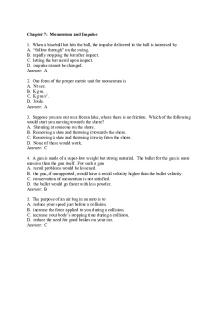Impulse Momentum Lab Report PDF

| Title | Impulse Momentum Lab Report |
|---|---|
| Course | Introductory Physics I |
| Institution | The Pennsylvania State University |
| Pages | 3 |
| File Size | 192.2 KB |
| File Type | |
| Total Downloads | 21 |
| Total Views | 136 |
Summary
PHYS 250 Lab Reports...
Description
Physics 250 Lab Section 1 Lab #7 Impulse and Momentum Morgan Reightneour
Purpose: We shall determine the impulse-momentum relationship using a cart and sensor apparatus. We did this by measuring collision force as it varies with time throughout the collision. To do this we used a force sensor that detected when the moving cart collided with the still force sensor. Since this sensor could detect the position of the cart compared to time, the velocity could be calculated. The computer then graphed force vs. time and also the cart’s velocity vs. time. We then used a statistics package to integrate the force vs. time curved to obtain the impulse. The initial and final velocities of the cart were also obtained so we could calculate the initial and final momentum. Once we calculated the momentum, we could test the relationship between momentum and impulse. Results:
Data:
Table 1: All data collected using Cart and Sensor Apparatus.
Calculations: Flexible Spring 2: ∆ Momentum cart (Kg-m/s) = Delta V * Total Mass 0.56 = 0.56 * 1.0 {[∆ Momentum cart (Kg-m/s)- Impulse resultant F (Ns)]/ Impulse resultant F (Ns)} *100= % dif {(0.62-0.57)/0.57} * 100= 8.8%
Results and Conclusions: Through experimentation we were able to determine the impulse-momentum relationship with the use of a cart and sensor apparatus. We measured the collision force as it varied with time throughout the collision and found that the force varied with the use of a flexible spring, a firm spring, a rubber bumper, and a magnetic bumper. The forces varied between 0.51 N and 0.63 N. To measure these forces, we used a force sensor that detected when the moving cart collided with the still force sensor. Since this sensor could detect the position of the cart compared to time, the velocity could be calculated. The initial and final velocities were found and used to calculate the delta velocity or the change in velocity with respect to time. The computer then graphed force vs. time and also the cart’s velocity vs. time. The initial and final momentum were then calculated using the velocity which we ultimately used to find the percent difference. We found that for the first run using the flexible spring the momentum was 0.56 kg-m/s and the impulse resultant force was 0.56 N, therefore we found a 0% difference. For the second run using the flexible spring the momentum was 0.62 kg-m/s and the impulse resultant force was 0.57 N, so we obtained a 8.8% difference. For the first run using the firm spring we found that the momentum was 0.61 kg-m/s and the impulse resultant force was 0.61 N, so we obtained a 0% difference. For the second run using the firm spring we found that the momentum was 0.63 kgm/s and the impulse resultant force was 0.63 N, so we obtained a 0% difference. For the first run using the rubber bumper we found that the momentum was 0.53 kg-m/s and the impulse resultant force to be 0.51 N, so we obtained a 3.9% difference. For the second run using the rubber bumper we found the momentum was 0.55 kg-m/s and the impulse resultant force to be 0.54 N, so we obtained a 1.9% difference. For the final run we used a magnetic bumper and obtained a momentum of 0.55 kg-m/s for the first run and the impulse resultant force of 0.54 N to obtain a 11.9% difference. For the second run using the magnetic bumper we found a momentum of 0.59 kg-m/s and an impulse resultant force of 0.57 N to obtain a 3.5% difference. These percent differences allowed us to compare the momentum to impulse resultant force relationship. The experimental values are not perfect as we see that reflected in our percent differences. A source of error that we did not account for is gravity. Gravity is an important factor to take into account, but if there is no ability to do so then our numbers would be expected to be a tad off....
Similar Free PDFs

Impulse Momentum Lab Report
- 3 Pages

Lab 8 (Impulse and Momentum)
- 2 Pages

Impulse-Momentum Equation
- 3 Pages

Impulse and Momentum worksheet
- 2 Pages

Lab 9 (impulse and momentum II)
- 2 Pages

Linear Momentum Lab - Lab report
- 5 Pages

Chapter 7 - Impulse and Momentum
- 10 Pages

Chapter 7 Momentum and Impulse
- 9 Pages

Lab Report 5 -Angular momentum
- 6 Pages

Conservation of momentum lab report
- 11 Pages

Impulse Lab - lab
- 6 Pages
Popular Institutions
- Tinajero National High School - Annex
- Politeknik Caltex Riau
- Yokohama City University
- SGT University
- University of Al-Qadisiyah
- Divine Word College of Vigan
- Techniek College Rotterdam
- Universidade de Santiago
- Universiti Teknologi MARA Cawangan Johor Kampus Pasir Gudang
- Poltekkes Kemenkes Yogyakarta
- Baguio City National High School
- Colegio san marcos
- preparatoria uno
- Centro de Bachillerato Tecnológico Industrial y de Servicios No. 107
- Dalian Maritime University
- Quang Trung Secondary School
- Colegio Tecnológico en Informática
- Corporación Regional de Educación Superior
- Grupo CEDVA
- Dar Al Uloom University
- Centro de Estudios Preuniversitarios de la Universidad Nacional de Ingeniería
- 上智大学
- Aakash International School, Nuna Majara
- San Felipe Neri Catholic School
- Kang Chiao International School - New Taipei City
- Misamis Occidental National High School
- Institución Educativa Escuela Normal Juan Ladrilleros
- Kolehiyo ng Pantukan
- Batanes State College
- Instituto Continental
- Sekolah Menengah Kejuruan Kesehatan Kaltara (Tarakan)
- Colegio de La Inmaculada Concepcion - Cebu




